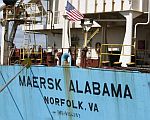From the New York Times: Hollywood gave a big boost to the myth that captains could legally join couples on the open seas. In New York, Captain Arnold Wonsever, an ordained minister, is making this myth a reality.
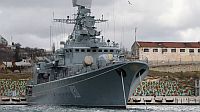 Update: Reports of the defection of the frigate Hetman Sahaidachny are being denied by the Ukrainian military. The ship is reported to have be sighted in port in Crete still flying the Ukrainian flag.
Update: Reports of the defection of the frigate Hetman Sahaidachny are being denied by the Ukrainian military. The ship is reported to have be sighted in port in Crete still flying the Ukrainian flag.
There are reports that the Ukraine’s Navy flagship, the frigate Hetman Sahaidachny, is refusing to follow orders from Kiev and has defected to Russia. The ship is returning home after taking part in NATO operation in the Gulf of Aden and is claimed to be flying the Russian naval flag.
Ukrainian Navy flagship takes Russia’s side – report
Continue reading
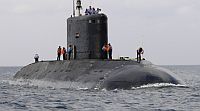 Two Indian naval officers, Lieutenant Commander Kapish Muwal and Lieutenant Manoranjan Kumar, died in a fire on the submarine INS Sindhuratna. Seven sailors were evacuated suffering from smoke inhalation. The fire broke out around 40 nautical miles off Mumbai early Wednesday morning. The submarine was undergoing sea trials following a refit at the Mumbai dockyard from May to December last year. The fire started in the battery compartment. 94 naval personnel were aboard the submarine.
Two Indian naval officers, Lieutenant Commander Kapish Muwal and Lieutenant Manoranjan Kumar, died in a fire on the submarine INS Sindhuratna. Seven sailors were evacuated suffering from smoke inhalation. The fire broke out around 40 nautical miles off Mumbai early Wednesday morning. The submarine was undergoing sea trials following a refit at the Mumbai dockyard from May to December last year. The fire started in the battery compartment. 94 naval personnel were aboard the submarine.
This is the second deadly accident on one of the Indian Navy’s Soviet Kilo Class submarines within the last few months. In August , the INS Sindhurakshak caught fire, exploded and sank while at Mumbai’s naval dockyard. The submarine has yet to be fulled salvaged but eighteen sailors are believed to have died.
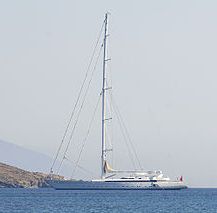
Mirabella V at Rineia, Cyclades in 2008
I recently read of the successful sea-trial of the remodeled super-yacht M5, (ex Mirabella V.) They were testing what is described as the “new carbon rig.” The new rig includes 34 new carbon fibre stays and titanium fittings with built-in dynamic fiber optics, which decreases the weight of the rig by 18 tonnes. The M5 is the largest single-masted yacht with a sail area of 3,380 m² / 36,490 sq ft. To put that in perspective, that is more sail area than the clipper ship Cutty Sark which had a sail area of around 32,000 sq ft spread over three masts. The M5‘s single mast soars to 292 feet above the waterline.
I am not sure why I find this to be so amusing. Here is a fish controlling a small robotic car by swimming around in a small tank. Thanks to Alaric Bond for passing along the story. As described by the designers at Studio diip:
By using a camera and computer vision software it is possible to make a fish control a robot car over land. By swimming towards an interesting object, the fish can explore the world beyond the limits of his tank.
 Last July, I was pleased, and more than a bit surprised, to see a play in New York City about a shipyard. It was Off-Broadway and only a two man play, but nevertheless, it was about a shipyard. The play, The Boat Factory, which I described in my review as “a complicated love story” was about two men’s relationship with the Harland and Wolff shipyard in Belfast. Now, wonder of wonders, there is a Broadway musical featuring the rock star, Sting, no less, with a similar theme — a tribute to the shipyard, Swan Hunter, and the way of life that grew around it on Tyneside.
Last July, I was pleased, and more than a bit surprised, to see a play in New York City about a shipyard. It was Off-Broadway and only a two man play, but nevertheless, it was about a shipyard. The play, The Boat Factory, which I described in my review as “a complicated love story” was about two men’s relationship with the Harland and Wolff shipyard in Belfast. Now, wonder of wonders, there is a Broadway musical featuring the rock star, Sting, no less, with a similar theme — a tribute to the shipyard, Swan Hunter, and the way of life that grew around it on Tyneside.
The musical is “The Last Ship” with music and lyrics by the 16-time Grammy Award-winning singer Sting; a book by the Tony Award-winning author, John Logan, and the Pulitzer Prize winning, Brian Yorkey, choreography by Olivier Award winner Steven Hoggett; and directed by the two time two-time Tony Award winner Joe Mantello. The musical is expected to open in the Fall of 2014 at the at the Neil Simon Theatre, in New York City. from The Last Ship website:
THE LAST SHIP is set in the English seafaring town of Wallsend, a close-knit community where life has always revolved around the local shipyard and the hardworking men construct magnificent vessels with tremendous pride. But Gideon Fletcher dreams of a different future. He sets out to travel the world, leaving his life and his love behind. When Gideon returns home 14 years later, he finds the shipyard’s future in grave danger and his childhood sweetheart engaged to someone else. As the men of Wallsend take their future into their own hands and build a towering representation of the shared dream that defines their existence, Gideon realizes that he left behind more than he could have ever imagined.
THE LAST SHIP is a portrait of a community so bound together by passion, faith and tradition, they’ll stop at nothing to preserve the only life they’ve ever known.
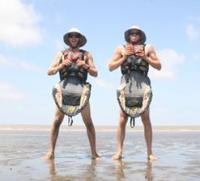 Russell and Graham Henry, two brothers from British Columbia, hauled their kayaks ashore in Juno Beach, Florida over the weekend. They had set out from the mouth of the Amazon river in Belém Brazil on July 30, 2013. In their 207 day expedition, they paddled 6,500 km and visited 23 different countries and territories. Their website describes the brothers: “Growing up in Victoria BC, Russell (21) and Graham (22) have been partners in crime since their earliest days of exploration.”
Russell and Graham Henry, two brothers from British Columbia, hauled their kayaks ashore in Juno Beach, Florida over the weekend. They had set out from the mouth of the Amazon river in Belém Brazil on July 30, 2013. In their 207 day expedition, they paddled 6,500 km and visited 23 different countries and territories. Their website describes the brothers: “Growing up in Victoria BC, Russell (21) and Graham (22) have been partners in crime since their earliest days of exploration.”
Adventure for ‘the hell of it’: B.C. brothers make 7,000 km Atlantic voyage for fun, not fundraising
Sometimes, Monday morning can feel like a train-wreck, or perhaps a boat-wreck. Here in the Extreme Sailing Series 2014 – Singapore, the Aberdeed boat ends up literally on top of the Groupma boat. Perhaps “prepare to repel boarders!” should be a new command at the turning mark.
Extreme Sailing Series 2014 – Singapore – Day 3 – Aberdeen Groupama Crash
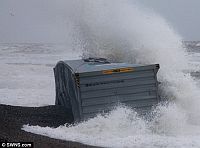 Last Wednesday, we posted about Svendborg Maersk, which last an estimated 520 containers in a storm in the Bay of Biscay. What happened to all the containers that fell overboard? One of them, loaded with a million cigarettes, may have just washed up on the beach in the Devon, England.
Last Wednesday, we posted about Svendborg Maersk, which last an estimated 520 containers in a storm in the Bay of Biscay. What happened to all the containers that fell overboard? One of them, loaded with a million cigarettes, may have just washed up on the beach in the Devon, England.
How many containers are washed over the side from container ship each year? No one really knows. Continue reading
The story of the “ghost ship” Mary Celeste is one of the great mysteries of the sea. The merchant brigantine was found 400 miles east of the Azores on December 5, 1872, unmanned and apparently abandoned in fair weather. What happened to the Captain, his family, and the crew has remained a puzzle. The mystery has been the subject of a range of wild theories and speculation, ranging from mutiny to pirates to sea monsters to killer waterspouts in countless articles and books. Now, with the discovery of a previously overlooked transcript of the Mary Celeste‘s log, the answer to the mystery may come down to an inaccurate chronometer and a faulty pump. Here is a fascinating documentary directed and produced by Anne MacGregor and funded in part by National Geographic, The True Story of the ‘Mary Celeste.’ See also Abandoned Ship: The Mary Celeste.
The True Story of the Mary Celeste
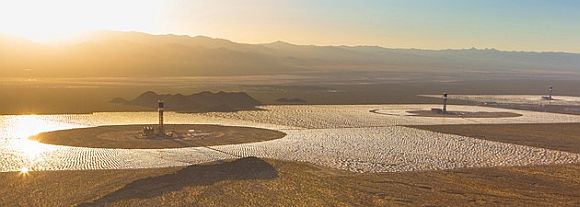
Archimedes Burning Mirrors Generating Electricity
During the Siege of Syracuse, 214–212 BC, Archimedes was said to have used “burning mirrors” to set fire to a Roman fleet attacking the city. The mirrors focused the rays of the sun and generated enough heat to set ships on fire. Long dismissed as folk-lore, researchers have been able to recreate the “burning mirrors” and have indeed set replica ships ablaze. (See our recent post, Archimedes “Burning Mirrors” and London’s “Walkie Scorchie.”) Now, in the Mojave desert at the Ivanpah Solar Thermal Power Facility, a modern day version of Archimedes “burning mirrors,” is being used to generate electricity in the world’s largest solar thermal power system.
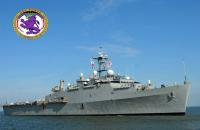 The Navy plans to deploy its first laser weapons on the USS Ponce, one of its oldest ships. The laser weapons designed to be capable of disabling small enemy vessels and shooting down surveillance drones will be installed on the 43 year old Ponce, an Austin-class amphibious transport dock.
The Navy plans to deploy its first laser weapons on the USS Ponce, one of its oldest ships. The laser weapons designed to be capable of disabling small enemy vessels and shooting down surveillance drones will be installed on the 43 year old Ponce, an Austin-class amphibious transport dock.
The lasers are extremely inexpensive to operate, if not necessarily to build. Lasers do have shortcomings, however, being less effective in rain, fog or dusty conditions. The Navy is also testing a high energy rail gun ashore. The problem with the rail gun is that it requires so much electricity so that the only ship with sufficient generating capacity is the new destroyer, the USS Zumwalt, under construction at Bath Iron Works in Maine.
US Navy ready to deploy laser system this summer; rail guns aren’t far behind
The USS Ponce has had an active and varied career. As we posted in July of 2012 she has been converted to an Afloat Forward Staging Base. Thanks to Irwin Bryan fro contributing to this post.
CNN is reporting that hypodermic needles and traces of narcotics were found with the bodies of two American security officers on the container ship Maersk Alabama, suggesting that the deaths resulted from drug overdoses, according to a Seychelles government official. Police said an autopsy would be carried out later this week.
Official: Traces of drugs found with dead Americans on ‘Captain Phillips’ ship
Joshua Slocum was born on February 20, 1844. After a career at sea, he rebuilt a 36′ 9″ (11.2 m) gaff rigged oyster boat, which he named Spray. Between 1895 and 1898, he sailed the Spray singlehanded around the world, the first to ever sail around the world alone. In 1900, he wrote the sailing classic, Sailing Alone Around the World, which became an international best-seller. He disappeared in November 1909 while aboard the Spray. A very well done documentary of his life :
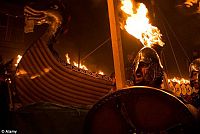 Some are predicting that the world will end Saturday, February 22, 2013, with Ragnarök, also known as Götterdämmerung, by the operatic among us. A reasonable response might be, “the world is ending — again?” We have lived through Y2k, the Mayan Apocalypse, the “Rapture” and a more than a few other end-of-the-world predictions. At least the Viking version sounds like it would make an exciting weekend. Here is how it is supposed to go down, according to the Daily Mail:
Some are predicting that the world will end Saturday, February 22, 2013, with Ragnarök, also known as Götterdämmerung, by the operatic among us. A reasonable response might be, “the world is ending — again?” We have lived through Y2k, the Mayan Apocalypse, the “Rapture” and a more than a few other end-of-the-world predictions. At least the Viking version sounds like it would make an exciting weekend. Here is how it is supposed to go down, according to the Daily Mail:
Continue reading
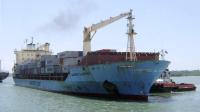 It is being reported that two American security guards, both former Navy SEALs, have been found dead on the Maersk Alabama while in Port Victoria, in the Seychelles. The men have been identified as Jeffrey Reynolds and Mark Kennedy, both 44, employees for the Trident Security Firm. Police said the cause of death will be determined by autopsies.
It is being reported that two American security guards, both former Navy SEALs, have been found dead on the Maersk Alabama while in Port Victoria, in the Seychelles. The men have been identified as Jeffrey Reynolds and Mark Kennedy, both 44, employees for the Trident Security Firm. Police said the cause of death will be determined by autopsies.
The Maersk Alabama was hijacked by Somali pirates in 2009. The hijacking and subsequent rescue of the captain by Navy SEALs inspired the movie “Captain Phillips,” starring Tom Hanks. The Maersk Alabama has been attacked two other times since the hijacking, but in both cases the pirates were driven off by security guards on the ship. Thanks to Phil Leon for contributing to this post.
The initial reports that the Svendborg Maersk lost 200-300 containers in a storm on Friday in the Bay of Biscay have turned out to be optimistic. The number is now estimated to be around 520. 85% of the boxes lost were reported to be empty. This will, no doubt, significantly reduce the potential cargo claims to Maersk, but may increase the hazard to navigation to fishing and other vessels in the area, as empty boxes may take longer to sink that full containers. Maersk said none of the boxes contained dangerous goods.
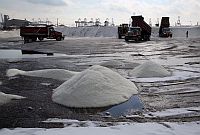
Photo:Richard Perry/New York Times
International Salt, a major salt company, has just about run out of salt to supply the State of New Jersey. The salt is used to control ice on the roads, and to run out in the middle of a very snowy winter is very, very bad. The company does have lots of salt in Maine, roughly 40,0000 tons, but apparently did not make arrangements to ship it to New Jersey in a timely manner. Was this just a logistical foul-up by the salt supplier? Not if you read the newspapers, the internet or watch television. The villain, at least according to what one hears in the press, is the Jones Act.
The Jones Act is a law which reserves the carriage of goods between US ports to US flag vessels. It is an easy scapegoat. It allows the state officials, who might not have been paying proper attention, as well as the salt provider, which is owned by a German multinational, to blame a nearly 100 year old law for their lack of planning. Simply put, everyone can say, “It’s not our fault. It is the Jones Act!”
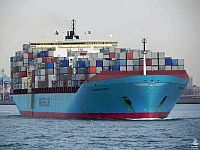 Maersk Lines is reporting that the 7,200 TEU container ship Svendborg Maersk lost a “significant number of containers over board” on Friday while crossing the Bay of Biscay. Lloyds List is reporting that 200-300 containers were lost in heavy weather while noting that the “full tally could be higher.” The wind was reported to be blowing at 60 knots and waves were 10 meters high at the time of the loss. Maersk say that “Other containers onboard are damaged as a result of collapsed stacks.” The crew is reported to be safe and accounted for. The 1998-built ship was said to have rolled 40 degrees in the severe weather. The incident is believed to be the biggest container loss in a single incident ever suffered by Maersk Line. The Svendborg Maersk docked in port of Malaga on February 17, for container re-stowage and repairs to the ship.
Maersk Lines is reporting that the 7,200 TEU container ship Svendborg Maersk lost a “significant number of containers over board” on Friday while crossing the Bay of Biscay. Lloyds List is reporting that 200-300 containers were lost in heavy weather while noting that the “full tally could be higher.” The wind was reported to be blowing at 60 knots and waves were 10 meters high at the time of the loss. Maersk say that “Other containers onboard are damaged as a result of collapsed stacks.” The crew is reported to be safe and accounted for. The 1998-built ship was said to have rolled 40 degrees in the severe weather. The incident is believed to be the biggest container loss in a single incident ever suffered by Maersk Line. The Svendborg Maersk docked in port of Malaga on February 17, for container re-stowage and repairs to the ship.

Nantucket Camel Ride
In the United States, today is “Presidents’ Day,” a national holiday on the third Monday of February, falling between Lincoln’s (February 14th) and Washington’s (February 22) birthdays. Here is a repost of the tale of Lincoln’s camel that we ran back in 2010.
Continue reading


